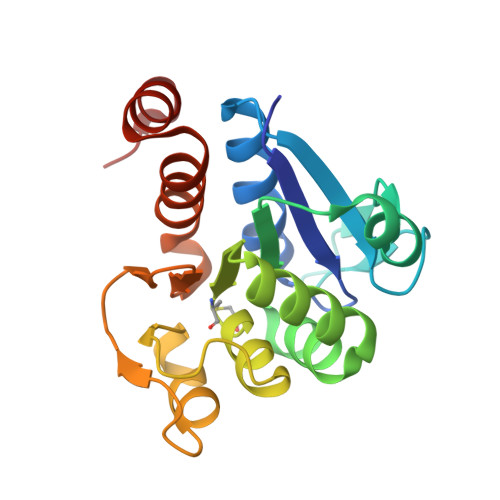A transient post-translational modification of active site cysteine alters binding properties of the parkinsonism protein DJ-1.
Mussakhmetov, A., Shumilin, I.A., Nugmanova, R., Shabalin, I.G., Baizhumanov, T., Toibazar, D., Khassenov, B., Minor, W., Utepbergenov, D.(2018) Biochem Biophys Res Commun 504: 328-333
- PubMed: 30190129
- DOI: https://doi.org/10.1016/j.bbrc.2018.08.190
- Primary Citation of Related Structures:
6E5Z, 6M8Z - PubMed Abstract:
Mutations in the human protein DJ-1 cause early onset of Parkinson's disease. A reactive cysteine residue (Cys 106 ) of DJ-1 is crucial for its protective function, although the underlying mechanisms are unclear. Here we show that a fraction of bacterially expressed polyhistidine-tagged human DJ-1 could not be eluted from a Ni-nitrilotriacetate (Ni-NTA) column with 150 mM imidazole. This unusually tight binding was accompanied by the appearance of blue violet color on the Ni-NTA column. We demonstrate by X-ray crystallography that Cys 106 is carboxymethylated in a fraction of DJ-1 tightly bound to Ni-NTA and that the replacement of Cys 106 by serine abrogates the tight binding and the appearance of blue violet color. However, carboxymethylation of purified DJ-1 is insufficient to confer the tight binding to Ni-NTA. Moreover, when eluted protein was re-applied to the Ni-NTA column, no tight binding was observed, indicating that the formation of high affinity complex with Ni-NTA depends on a transient modification of Cys 106 that transforms into a Cys 106 -carboxymethyl adduct upon elution from Ni-NTA. We conclude that an unknown metabolite reacts with Cys 106 of DJ-1 to result in a transient post-translational modification. This modification is distinct from simple oxidation to sulfinic or sulfenic acids and confers altered binding properties to DJ-1 suggesting that it could serve as a signal for sensing oxidant stress.
Organizational Affiliation:
National Center for Biotechnology, Astana, 010000, Kazakhstan.
















